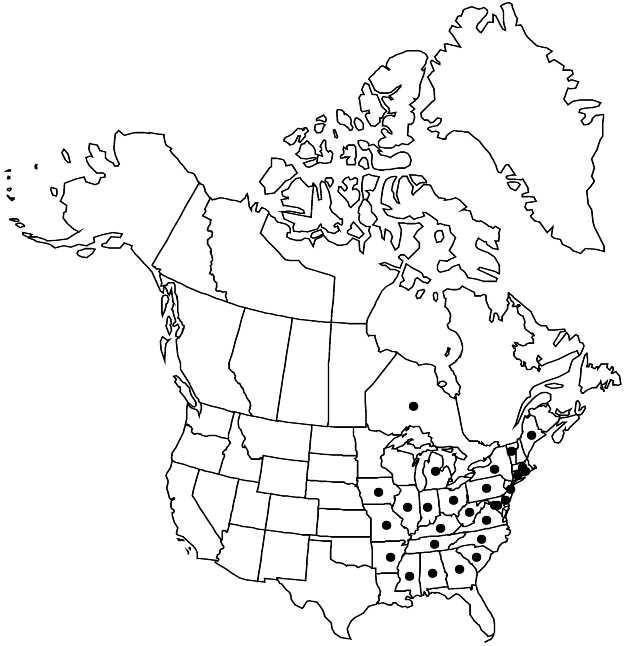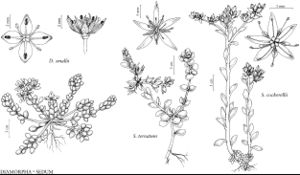Sedum ternatum
Fl. Bor.-Amer. 1: 277. 1803,.
Herbs, perennial, often mat-forming, glabrous. Stems decumbent, few-branched, (finely papillose), bearing terminal rosettes. Leaves in whorls of 3, rarely 2 or 4 or decussate, spreading to ascending, shortly petiolate or sessile; blade pale yellow-green to dark green, not glaucous, obovate to obovate-spatulate or elliptic, laminar, 10–17 × 7–11 mm, base truncately short-spurred, not scarious, apex truncate or rounded, sometimes emarginate, (surfaces finely papillose or crenulate). Flowering shoots erect, simple, 4–20 cm, (papillose); leaf blades obovate to obovate-spatulate or elliptic, base short-spurred; offsets not formed. Inflorescences cymes, 5–25-flowered, 3-branched, (sometimes papillose); branches recurved in bud, becoming ± erect at anthesis, not forked; bracts similar to leaves. Pedicels absent or to 1 mm, (papillose, almost glandular). Flowers 4(–6)-merous; sepals spreading to erect, connate basally, pale yellow-green, lanceolate-oblong or elliptic, equal, 2.4–5 × 0.8–1.7 mm, apex obtuse, (finely papillose); petals erect to spreading, distinct, white, elliptic-lanceolate, abaxially carinate, adaxially channeled, 5.4–8.9 mm, apex acute; filaments white, (flattened basally); anthers red or purple; nectar scales yellow or pale yellow, oblong or subquadrate. Carpels widely divergent in fruit, distinct, brown. 2n = 32.
Phenology: Flowering spring–early summer.
Habitat: Alluvial forests, fertile and mesic upland forests, rocky slopes, bluffs, cliffs, and shaded rock outcrops of sandstone, shale, limestone, quartzite, and other kinds of rocks, usually wooded habitats including stream banks, gullies, rocky slopes, ledges
Elevation: 50-1700 m
Distribution

Ont., Ala., Ark., Conn., Del., D.C., Ga., Ill., Ind., Iowa, Ky., Maine, Md., Mass., Mich., Miss., Mo., N.J., N.Y., N.C., Ohio, Pa., R.I., S.C., Tenn., Vt., Va., W.Va.
Discussion
Sedum ternatum has conspicuous pale-brown lips along the adaxial suture of the mature follicles. The anthers are horseshoe-shaped. It is found in the Appalachian highlands from Georgia to New Jersey, southern and western Pennsylvania, and Ohio; on the interior low plateaus and the central lowland from Ohio to Missouri and Iowa; on the coastal plain in Maryland and Virginia; on the Ozark plateau in Missouri; in the Ouachita Mountains on the eastern slope of Magazine Mountain in Arkansas; and in scattered localities in New England, New York, and southern Michigan. Now known in Ontario only as a garden escape, it may have been native originally in the Niagara area, where it was collected in a natural setting in 1823.
Selected References
None.
